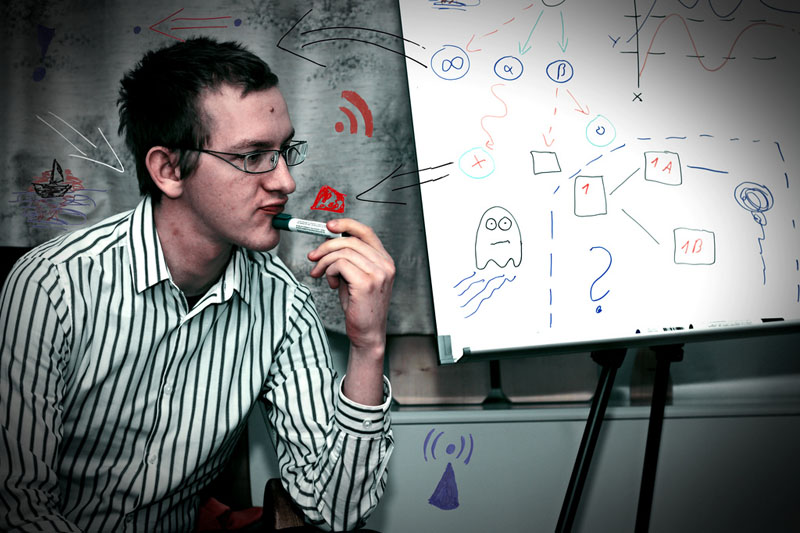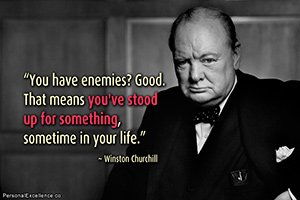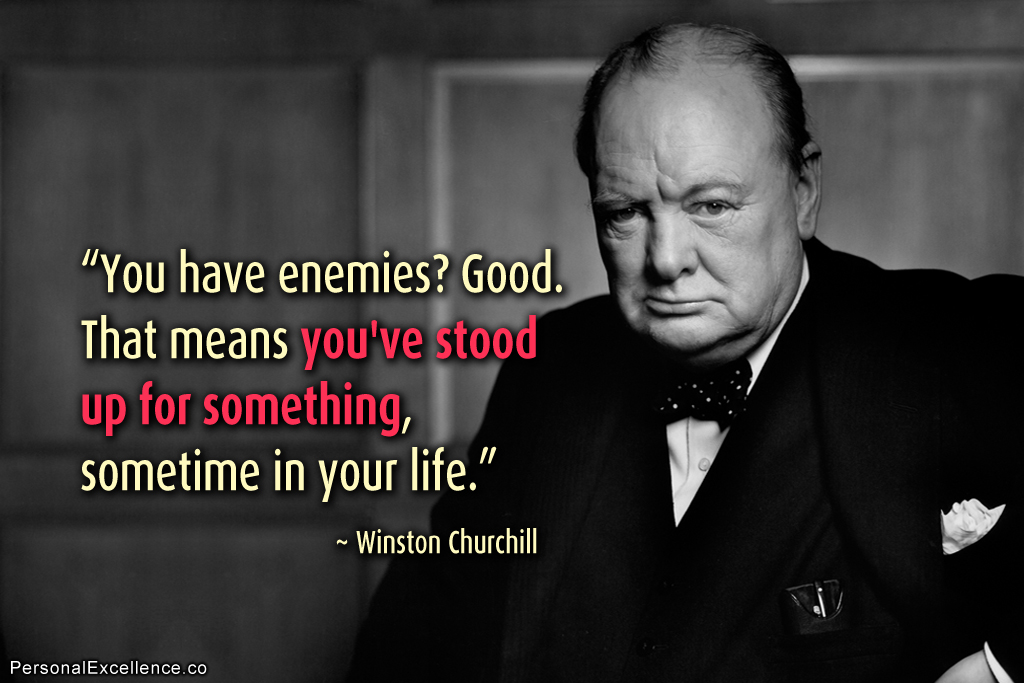
(Image: salendron)
Hi Celes, [how would you recommend] organizing one interests for maximum productivity? A lot of people, myself included are passionate about lots of things, and while it’s sound advice to just hone in on the few things that really matter, there’s always the idea creep where you keep getting little project ideas and little offshoot projects etc… These can weigh down progress. I’ve been really focusing on just a few things and for the most part it’s working for me but I’d really love to hear your take on it. — Jeff
What do you do when you have too many ideas you want to work on but limited time?
For the first few years after starting PE, this was a situation I was constantly in. Every time I worked on something, new ideas would pop out of nowhere. I would be torn between (a) continuing what I was doing and (b) embarking on my latest idea. Doing the former meant the new idea would have to be put on hold. On the other hand, doing the latter meant I had to put whatever I was doing on hold. Doing both at the same time was a no-go since it would split my attention two ways. It seemed like I could never win.
Too Many Ideas, Not Enough Time
For example, here are some of my business to-dos (and want-to-dos) during 2011:
- Create new content — Write new articles
- Continue current marketing approaches (Guest posting, media outreach, etc.)
- Explore new marketing strategies (Check out new social media sites, etc.)
- Increase revenue
- Start a new video channel (which has since been launched as my YouTube channel in Feb ’12)
- Create a new e-book
- Create a new course
- Create e-book versions of successful past challenges
- Collaborate with a similar-size blog to create a product or service
- Create a blogging e-book (for readers interested in blogging)
- Conduct another round of Blogging Success Course, my blogging course
- Create a follow-up blogging course / blogging mentorship program for ongoing support
- Conduct a new challenge
- Grow my Facebook page and Twitter
- Approach literary agents to explore book deal opportunities (for traditional publishing)
Ideas would come and go on an ongoing basis, but the trend was that I would always have more ideas than I could execute.
Path A: Maximizing My Personal Productivity
Not wanting to hire (it’s simply not in line with my business model) nor outsource (I wasn’t ready to outsource then), my only options left were to (a) prioritize my tasks better and (b) work faster.
I cultivated many productivity habits during this time. I developed a good eye for trimming things down to essentials. I said no to anything that would take me away from my goals. I became more efficient. I developed my own productivity system that helped me stay on top of all my projects and get the best out of my days. From 2009 through 2010, I became quite the fast worker.
Path B: Zooming Down to 2-3 Big Priorities
Working fast is great, but there’s a limit to how fast you can work. I realized that I needed to be choiceful, so in 2010, I started a new habit whereby I would select two to three priorities and work on these priorities and nothing else for a few months.
By then, I had eliminated many Quadrant 3 and 4 tasks and was focusing on my Quadrant 2, high-value tasks every day, so this new strategy was a step up where I would focus on my biggest priorities within Quadrant 2. These would usually comprise of two ongoing priorities and one new project. For example, “Marketing the blog” (ongoing), “Content creation” (ongoing), and “Write new e-book” (new). Or “Create/Run a new challenge” (new), “Marketing the blog” (ongoing), and “Optimize website layout” (ongoing). And so on.
This helped immensely in driving focus. For any new ideas that came in while I was working on other priorities, I would add them on my “emerging ideas” list and wait till my next review before considering them. After I was about 95% done with current priorities, I would identify my next two to three big priorities, and work on them next. And so on.
Using this approach, I launched various high quality e-books, conducted various challenges, wrote many new articles, increased PE’s web traffic by over 10 times, launched PE forums, expanded PE from being just a blog to a personal development platform, conducted numerous workshops, and worked with many new one-to-one coaching clients — all between 2010 and 2011. Without a doubt, this method helped me to be very prolific.
However, Some Limitations
In spite of that, I still felt something was off:
- Every time I worked on my big priorities, I couldn’t work on anything else. Everything had to be put on hold until I was done. (Yet, if I didn’t prioritize, I would be faced with the original problem of a scattered, ever-growing to-do list. It was a catch 22.)
- There were times when I questioned the trade-offs of working on these big priorities and them only. For example, writing a new e-book over conducting a new course. Isn’t it possible that the course may turn out to be more rewarding project the e-book? Or say, isn’t it possible that I may miss something important while busy writing the e-book? I can never know.
- At times I felt torn between the priorities I had zoomed down to. Say I chose to create an e-book and run a new challenge. With creating a new e-book, I have to plan, write, design, create the sales page, and market the book. With running a new challenge, I have to create a theme, design the tasks, design the marketing material, do the marketing, set up the forum, write the launch material, and then write the daily tasks and oversee the running of the challenge. These are all tasks that take time, and I can’t be doing two things at once.
The more I used this approach, the more glaring these issues became. It wasn’t until last year when I finally discovered the answer to my conundrum.
Aha Moment: Realizing there’s a Path C
So it was yet another review session for me, where I was identifying my new priorities for the next quarter.
As I started my evaluation process of weighing one project over another to decide which to work on, I felt conflicted. Must I really choose one thing over another again? I thought. But all of them are important in their own way. Is it yet another few months of doing A and B only while ignoring C and D? I felt weary; jaded.
As I lingered over the items on my list — Marketing my blog, creating content, increasing revenue, launching new e-books, launching new courses, releasing more freemiums, etc. — suddenly, something clicked. Suddenly, I saw a pattern that I had never seen before. As it turned out, I don’t have to choose two to three priorities. Neither do I have to choose between my two to three shortlisted priorities.
That’s because all my “priorities” really converge to the same end point eventually.
Allow me to explain.
Example #1: Focus on Revenue Generation
Let’s say I pick revenue generation as my top priority for the next two months. In my business, this usually means creating a new high value information product. While creating a new product takes a good one to two months, I receive the reward right after launching it, in terms of the revenue generated from sales. Post launch, this will become as an additional, permanent revenue stream to my business. Clearly, this accomplishes my revenue objective.
However, creating a product will do more than just give me extra income. It will also…
- Strengthen my value offering at PE, because I will have a new high value product in my products lineup at PE. Many readers will benefit from this product as opposed to if I had never launched it.
- Help me reach new people, since the people who purchase it may mention it in passing to their friends too, due to the immense benefits they get from using it. This has been the case for Live a Better Life in 30 Days, Be a Better Me in 30 Days, and other PE courses.
So not only do I get more income from launching a new product, I’ll also improve my site content and increased readership/awareness of PE at the same time.
Example #2: Focus on Content Creation
Now, let’s consider a different example. Let’s say, I choose content creation as my priority for the next two months. This means writing high quality articles on PE for free as I’ve been doing in the past few years. Creating new content will help to improve the value of the PE content to existing readers.
However, is this the only effect? No, not at all. Assuming the articles are well-written and resonate with readers, some will proactively share them with their friends and family, simply because they want their loved ones to benefit from the material. This will…
- Lead to an organic growth in traffic due to word of mouth.
- With the traffic growth, it will lead to an increase in revenue, since higher readership means a higher chance of product sales as well as higher clickthroughs for the site advertisements.
Clearly, when I build my content, I’m not just growing my content: I’m also growing the PE in other aspects, including growing my traffic and increasing my revenue, thanks to the spillover effects of growing my content. I’m not just doing one thing — I’m really accomplish three things at the same time.
Suddenly, what seemed like conflicting priorities in my business all this while aren’t conflicting priorities… they are simply facets of the same goal — to have an abundant business in terms of readership, earnings, and value offering to the world. Whichever item I focus on, I’ll be simultaneously “accomplishing” the other items at the same time, so there’s no need to “choose” one thing over another per se, as much as it’s about choosing one thing that I care the most to work on.
Excellence at One Thing = Eventually Achieving Everything
This realization was huge, because for the first time, I realized everything on my to-do list is congruent with each other. There is no dichotomy or conflict. All of them are simply different river streams in the mountain, whereby all the streams with their nooks and crannies eventually lead me to the same big ocean.

One of many river streams that will bring us all to the same big ocean (Image: Nicholas Tonelli)
Of course, this can only happen because all my to-dos are already Quadrant 2 tasks — big rocks that move my business in the positive direction — and this came from first artfully prioritizing (as I shared in the opening) and creating the proper foundations in my business.
What this means is that rather than be confused and conflicted about which project to work on next, I should really (a) pick something and go, and (b) pick the thing that I’m most passionate about doing and that’s most in line with my personal mission, such that I can reap maximum rewards right away. For me, this means content creation (whether by way of articles or courses), since I enjoy sharing about my life and knowledge and working with people to help them grow. As I focus on this chunk and do it exceptionally well, traffic, revenue, and other pieces of the puzzle will naturally fall into place over time.
And it’s the same for you too. Whatever work items that you feel conflicted over prioritizing right now, chances are they really bring you to the same end place — of growth, of knowledge acquisition, of value creation to the world, of equipping yourself with better skills for your role, etc. (This is assuming that these items are already Quadrant 2 tasks). Many times, big projects/goals have more interrelated effects on each other than we think. This brings me to the Superstar Effect (and Superstar Halo).
The Superstar Effect (+ Superstar Halo): Winner Takes All

(Image: Katherine Anderson)
Do you know about the Superstar Effect? It’s an economic phenomenon where the top performers in a field (the superstars) enjoy a disproportionately larger share of revenue (compared to other players in the same field) and seemingly dominate the fields they are in (Wiki). It is commonly linked with economist Sherwin Rosen (who first wrote about it in The American Economic Review in 1981), and is really an iteration of the 80/20 principle, whereby 80% of the outcome can be explained by 20% of the causes. Here, a small percentage of the top players reap 80% of the rewards, kinda like “winner takes all.”
There have been much evidence of the superstar effect at work.
- In basketball, the top three earners in 2014 are Kobe Bryant, LeBron James, and Derrick Rose, with earnings of $59.8m, $57.6m, and $32.4m respectively. The other people in the top-10-earners rooster earn between $20m to $30m each. Needless to say, these 10 people combined probably earn more than 80% of basketball players in the world.
- In golf, we see the same pattern: the top earner in 2013 is Tiger Woods with a total earning of $83m. #2 is Phil Mickelson with $52m, followed by Arnold Palmer with $40m. The rest of the top-10 crew earn between $14m to $26m. That’s a lot of money.
- Similarly for acting, we see the same huge income divide: the top three earners in 2014 are Robert Downey, Jr. with $75m, Dwayne Johnson with $52m, and Bradley Cooper $46m. A stark contrast with the other end of the spectrum that is probably filled with struggling actors trying to make ends meet.
There are several reasons why the Superstar Effect exists:
- People, when given a choice, want the best, rather than the second or third best. For example, if you’re in New York City for a vacation and you want to listen to opera music, you’ll naturally want to book a performance by the best opera singer, not the second or third best. If your loved one is suffering from a heart condition, you’d want to look for the best heart surgeon and specialist in the world, not the second- or third-best.
- People are interested to follow the person who is best in his/her field, because that person epitomizes everything there is to see/know about his/her industry. He/she becomes more than just a person, but a symbol, an icon, a representation of everything there is to see and learn about that industry. Think Tiger Woods for golf (at least before his sex scandal), Mark Zuckerberg for social media, Michael Jordan and now Kobe Bryant for basketball, Kim Kardashian for reality TV / hollywood fame, and Steve Jobs for technology.
- While not a causal factor, technology has been accelerated and deepened the Superstar Effect. For example, economist Alan B. Krueger studied the music industry and found that the top 5% of revenue generators (the superstars) took in 62% of concert revenue in 1982 and 84% in 2003. Part of the reason is because technology — such as iTunes, social media, and Pandora — has allowed one’s influence and one’s work to spread more widely, more quickly, and more cost effectively than before. When you consider that musicians like Katy Perry, Justin Bieber, and Taylor Swift have some of the world’s largest Twitter accounts today (61m, 58m, and 48m followers respectively as of December 2014), it’s easy to understand why! (Source #1, Source #2)
Superstar Halo: Where Success in 1 Area Spills to Others
Now, the Superstar Effect subsequently gives rise to what I call the Superstar Halo, where one’s success in a domain creates positive spillover effects in other areas of their career.
For example, you have Justin Timberlake, who started out as a singer in NSYNC, enjoyed worldwide fame, and subsequently expanded into acting. He now enjoys tremendous success as a singer, songwriter, and actor, earning $57m in 2014 alone. Then there’s Selena Gomez, who started out as a child actor and is today highly established both as an actor and singer (and in fact, more known as the latter than former). There’s Tyra Banks, who became internationally famous as a supermodel, and then subsequently successfully expanded to doing reality TV (America’s Next Top Model), being a talkshow host (Tyra Show), being an author, and most recently creating her new makeup line. And who can forget the Kardashians, who rose to prominence with their reality TV series (though some will argue it was due to something else), and subsequently enjoyed success in almost every other industry (from modeling, to fashion retail, to cosmetics, to fragrances, to books, to mobile phone apps)?
While there is no denying that each of them must have worked really hard to make their new venture/career take off, it’s also undeniable that their earlier success helped pave the way for these future ventures to succeed. It’s why superstar celebrities seem to have Midas touch regardless of what they do — because they already have huge followings from their initial claim to fame, or at the very least established a certain level of prominence and credibility, this enables them to leverage on this success to create bigger waves of success elsewhere.
Implications of Superstar Effect (+ Halo) on You
There are four implications that the Superstar Effect (+ Halo) have on you:
- Whatever you do, the winner in your field will take all. By not working to be the winner in your niche, you’re not going to take much, if at all — others are.
- When you work on two, three, 10, or even more things at once, you make it slower for yourself to win at anything. You become a jack of all trades, master of none, as you’re constantly busy working on everything… with nothing taking off. (Read: 10,000 Hours To Develop Talent)
- Doing many things may make you think and feel like you’re making much progress, but you usually accomplish less in absolute terms, as compared to if you work on one thing and one thing only. By focusing on doing only one thing well, you have a much higher chance of succeeding.
- Upon doing your one thing well, you will naturally do well in other things you want to do, because you now have a platform of success. It may not be a direct transference of success from your first thing to the second (it will still be necessary to put in due work in other ventures), but it will now be relatively easier to excel in them, compared to if you had started off trying to do everything simultaneously at the beginning. This is due to the positive spillover success from your initial success.
What These All Mean for You: 5 Steps to Maximum Results
So what does this all mean?
However many ideas and goals you have now, it doesn’t matter which one you work on as much as you (1) pick ONE that you are most passionate about, (2) pursue it full throttle, and (3) stick with it till you achieve mastery and success. (This is assuming these are Quadrant 2 ideas/goals.) That’s because when you do one big thing and do it well, (1) you get tremendous rewards PLUS (2) it creates positive halo effects that pave the way for easier success in your other goals. Like a successful entrepreneur who make it big with his startup and ultimately leverages on this success to create more successful startups, becomes an angel investor, and mentors others in their businesses. Ultimately, no matter what you pick, you’ll arrive at your same ideal end vision of accomplishing everything on your list.
On the other hand, trying to do everything at one go and master everything at the same time typically doesn’t help; it usually adds more clutter and distraction than anything. Note that by two to three things, I mean two to three COMPLETELY different projects that take up a huge amount of your resources (like write a book, start a brand new blog, and start a new course all at the same time), not two to three small-scale tasks that don’t take up much of your time. Personally, I found that trying to do two to three things at one go can be very draining and distracting, as I’ve shared in the opening. When you’re handling three big projects that require your full attention, you constantly have to switch from A to B, from B to C, and then from C back to A. Your attention is split. You get a diffused output, compared to if you channel all your energy into one area and blast it full force.
There’s a reason why planes are designed with one head each, not two heads or three heads: it’s because that’s the most streamlined design that cuts through air resistance. It’s possible for laser light to cut through steel by producing laser light at a precise wavelength and focusing it on one precise area, after which even the strongest steel melts away under this intense power. Under the law of physics, you deliver the most pressure when you apply the same force over the smallest unit area (doing one thing), not over a larger unit area (doing multiple things at the same time).
If you’re constantly in a state of flux and jumping from one thing to the next, here’s my recommendation for you:
Step #1: Streamline your to-do list.
Most people have exceedingly long to-do lists. For most people, many to-dos are also non-consequential, whereby doing them perfectly won’t make any difference in their life after a week, month, or year.
Keep your list to the most essential, Quadrant 2 tasks. What are your 20% high-impact activities? Keep these. What are your 80% low-impact activities? Get rid of them if possible; if not, spend the bare minimal time to get them done.
Read:
- Put First Things First
- Get Your Big Rocks In First
- Live a Better Life in 30 Days, Day 8: Evaluate Your To-Do List (how to be more effective on a day-to-day basis).
Step #2: Pick one goal, and only one.
Based on your 20% high-value tasks, pick one goal that (a) you’re most passionate about doing and (2) is most in line with your personal mission. If you’re equally passionate about all of them, then just pick one. If you want to work to two to three other projects, you can, but make sure the bulk of your energy — at least 60 to 70% — is dedicated to your core, priority goal. A certain degree of focus is necessary to achieve quick results.
While it may seem like you’re abandoning all other priorities, remember that by working on this one thing, you are by corollary progressing in your other priorities — in more ways than you can imagine. As reader Alice shares in the comments section,
THANK YOU. I have about three major personal/work projects all of which I am passionate about (and must do) to complete this summer. I have been at a loss on where to start, or how to integrate the approach to attacking all three. Felt paralysed — how could I devote time to one when I should constantly be thinking of another?
You’ve just hit the nail on the head and inspired me to start — focusing solely on the first! And it’s true what you said — the skills I gain from that will definitely help in the second (both website development projects).
PE is my go-to site now; thank you :)
Step #3: Focus on this goal, and this goal only. Put your 110% energy into it.
Now, your priority is to achieve maximum success in your selected goal as quickly as possible, so as to achieve the Superstar Effect. Subsequently, you can leverage on this success for other areas in your life, ala using the Superstar Halo.
Some helping points
- Delegate, outsource, or discard anything that’s inconsequential. Read about delegating/outsourcing: Why You Should Outsource and How to Get Started
- Improve your personal productivity. Below are some of my best articles on productivity:
- Become the Master of Your Time (Fundamental principles of time management)
- 8 Habits of Highly Productive People (Inculcate these habits if you want to be more productive)
- 50 Ways To Boost Your Productivity (An arsenal of productivity tips to be more productive)
- The Best Productivity System There Is (Developing your productivity system to manage all your tasks)
- How To Finish What You Start: 10 Important Tips
- Embark on little tasks that ladder up to this main goal. Many people get confused by the instruction of “Focus on one thing” because they think that it means doing one TASK only. No! “Focus on one thing” means focus on your priority. In this case, it’s about focusing on your one big goal, whereby there can be many mini-steps that link to this main goal. For example, my one big goal of “Content creation” can involve content research, writing new articles, creating new videos, improving on current content, or even starting a new course (if it helps to enhance my content offering, as opposed to launching it purely for more revenue). It’s about doing what it takes to achieve maximum success in this goal.
Build a strong foundation in this goal before proceeding to the next step.
Step #4: After (and only after) making headway in goal #1, start goal #2.
Having achieved significant progress in your first goal, you would likely have ticked off a few other items on your list in the process. At this point, review your goals, and pick the next big goal you want to work on. Repeat Step #3 for goal #2.
While working on goal #2, be sure not to neglect goal #1. This is your core and should always be your number one priority. In any situation where goal #1 slips, stop whatever you’re doing in goal #2 and return to goal #1. Beat it into shape until its foundations are firmly in place, then move on to goal #2.
Step #5: Rinse and repeat for other goals.
Once you achieve significant progress with goal #2, you can now expand to other goals. Always take on new goals one at a time, meaning, branch into goal #3 only when goal #2 is in place, branch into goal #4 only when goal #3 is in place, and so on. Think of it as like brick layering, where you lay on a new brick only when the previous one is in place.
Once again, if at any point an old goal slips, return to work on it until it’s in place. Then, return to the latest goal you’re working on.
You will find that you now attract results much faster than when you were struggling to do multiple things in the past. :)
How about You?
What are you currently juggling with? How can you streamline your focus to one big thing? What is the one big goal that you want to work on moving forward?
Be sure to read: The Market Leader Effect: Where The Winner Takes All









 Thanks for reading. If you like my free articles, join my private email list and get my latest updates and articles sent right to your inbox.
Thanks for reading. If you like my free articles, join my private email list and get my latest updates and articles sent right to your inbox.